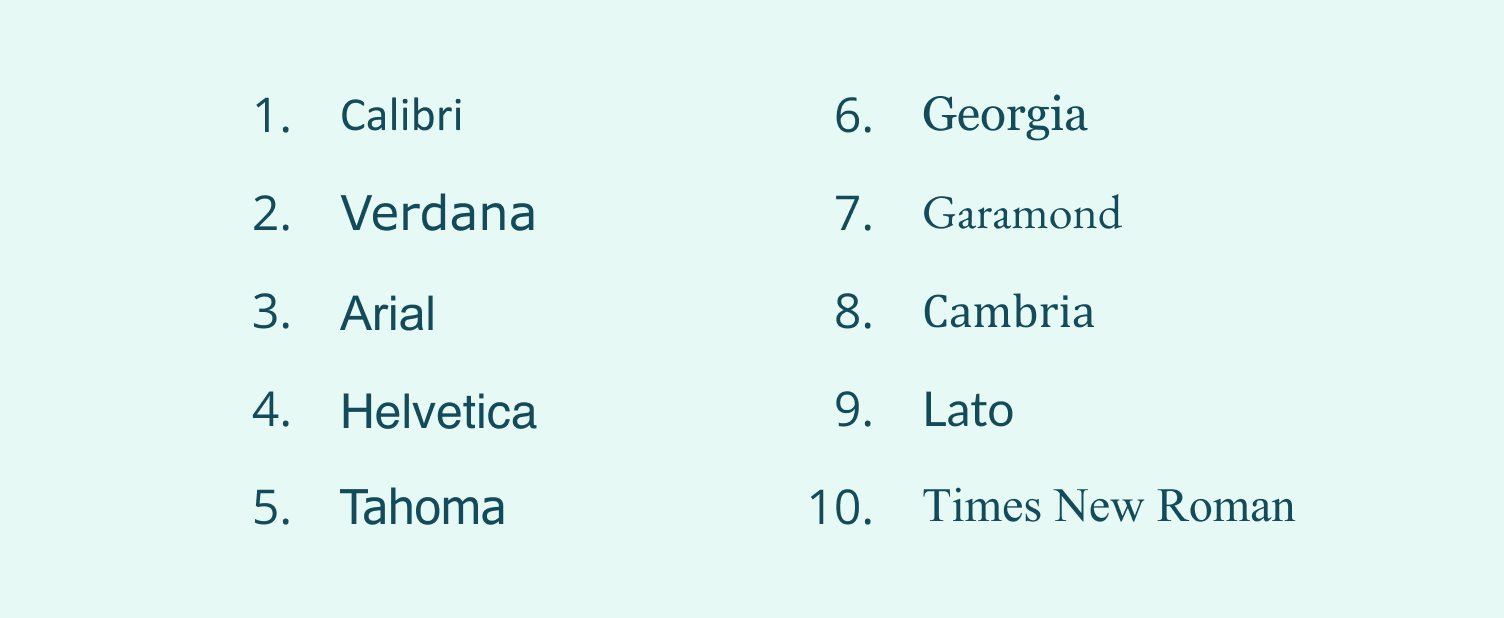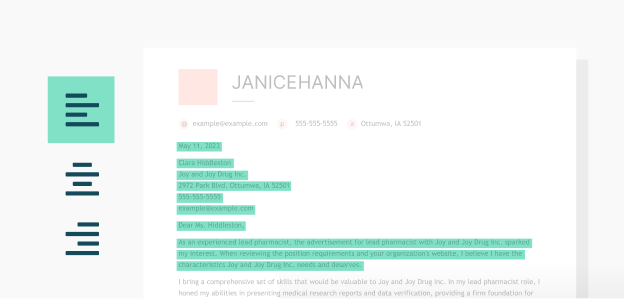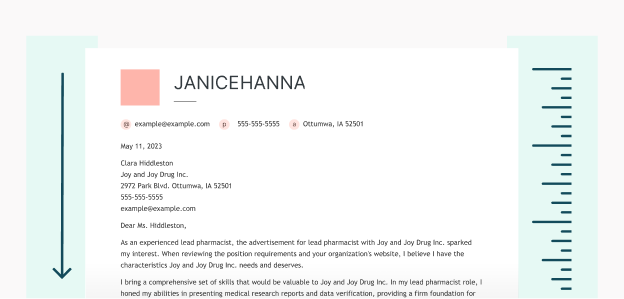The Proper Cover Letter Format
- A standard business letter layout.
- Your contact information. Match the same design and layout as your resume.
- The date and the hiring manager’s contact information.
- A professional greeting.
- An engaging opening paragraph.
- Up to three body paragraphs.
- A final paragraph that invites the recruiter to reach out.
- A signoff and typed signature.
You can find practical cover letter examples of well-formatted letters here.
3 Cover Letter Format Templates
Think of your cover letter format as the foundation of your house. These templates are the external siding and roofs that give your cover letter curb appeal! Feel free to customize these template styles with our helpful Cover Letter Builder.
Traditional cover letter format example
This cover letter sample uses a traditional business letter structure to help introduce and expand your resume.
Bulleted cover letter format sample
This proper cover letter format uses a bulleted list to highlight your key accomplishments and direct hiring managers to your strongest career qualifications.
Modern cover letter format example
This format of a cover letter can work as either an uploaded cover letter or the body of an emailed application to help introduce your resume.
How to Format Cover Letter Sections
We gave general formatting rules before — let’s cover how to format a cover letter’s sections. Use these rules and our cover letter writing guidelines to make the most of your resume and job application. However, make sure to match this header to your resume header.
1. Professional header
Your name and contact information are the sole exception to our left-justified rules. Using a center or right alignment can help this information stand out.
- Add your full name, email address, phone number and general location.
- Don’t add your full address.
- Match your cover letter heading to your resume.
Example of a cover letter heading:
John Smith
555-555-5555
john.smith@email.com
St. Louis, MO
PRO TIP:
Make sure your cover letter header matches your resume for a professional look.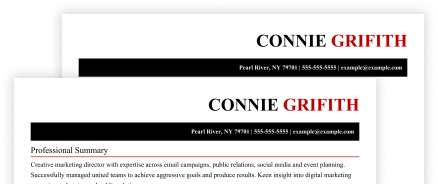
2. Hiring managers’ contact information
Your recipient’s contact information will follow this cover letter structure:
- Add the date, followed by a line break.
- Recipient’s name.
- Recipient’s job title.
- Company name.
- Company mailing address.
- Line break.
- Date of cover letter writing or submission.
- Line break.
Cover letter format example:
July 24, 2024
Jane Abbot, Recruiter
BC Company
123 Common St.
St. Louis, MO
3. Salutation
Use the following greetings, followed by a line break before the main body of your letter. Avoid vague or impersonal cover letter addresses greetings like “To whom it may concern.”
- Dear [recipient’s name],
- Greetings [recipient’s name],
- Hello [recipient’s name],
4. Introduction
How you start your cover letter can sway hiring managers’ interest and keep them reading! Keep this first paragraph limited to two or three lines under your document, followed by a line break to indicate the start of the next paragraph.
Example of a cover letter introduction:
My skills and qualifications are an ideal match for your accounting intern requirements and can bring immediate value to ABC Technologies’ goals. Throughout my internship, I positively contributed to business outcomes through effective organization, prioritization and execution of key projects.
5. Main body
Keep this section to one or two paragraphs, with a space between each one. In these paragraphs, identify one to two relevant skills and quantify them with examples and numbers.
How to write and format your main body paragraphs:
In my previous role as a student, I exercised a calculated and methodical approach to problem-solving. I am independently motivated but work well in collaborative environments and with established teams. I am also knowledgeable in account management and evaluation and proficient in preparing financial statements.
PRO TIP:
For greater impact, use a bullet points cover letter format to highlight core qualifications like improved website traffic, higher profit earnings, reduced spending or improved onboarding processes.
6. Concluding paragraph
End your cover letter with a short final paragraph summarizing your featured skills and offering suggested availability to connect for a potential job interview. Follow this paragraph with a line break.
Concluding paragraph example:
Please take a moment to review my attached resume to learn the full scope of my career history and accounting competencies. I appreciate your evaluation and look forward to a response. You can reach me most work days between 2 pm – 6 pm.
7. Salutation and signature
Close out your letter with a formal salutation, such as one of the following:
- All the best,
- Kind regards,
- Thank you for your time,
- Looking forward to our next communication,
Follow proper cover letter formatting rules by adding four paragraph breaks between your salutation and typed signature.
How to Format a Cover Letter for Email
Most online job applications ask for supplemental documents like cover letters, portfolios or work samples. Sometimes, you may need to include your cover letter in the body of an email.
Follow these steps on how to format a cover letter for emailed applications:
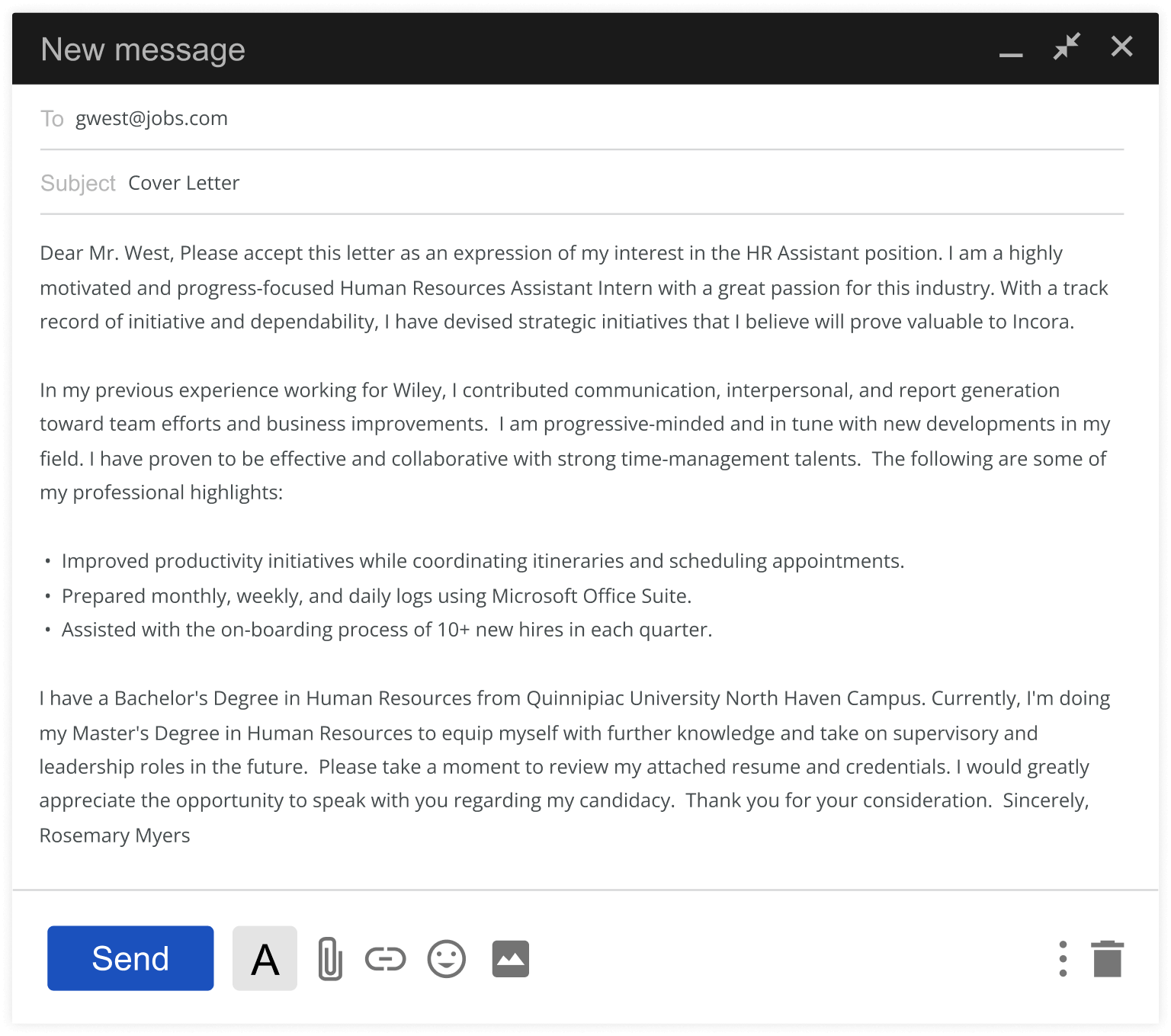
-
1. Fill in the cover letter recipient’s email address.
Copy the email specified in the job ad. If you’re applying for a job that wasn’t posted online, ask your professional connection for their work email address, or visit the company directory to find a list of department heads with their work emails. Copy this correctly into the “To:” address line.
-
2. Compose a direct subject line.
If you send your cover letter and resume as an email, include a clear subject line with your name and the position you’re applying for.
Avoid a vague subject line like “[Name] Cover Letter” unless you have a strong professional relationship with the recipient. Use a clear subject line like “ [Name] Resume and Cover Letter RE: [Open Job Position].”
-
3. Upload your cover letter.
Type or copy and paste your cover letter into the body of your email. Delete your contact information and the recipient’s mailing address — using email makes that information irrelevant.
-
4. Include relevant uploads or hyperlinks.
Click the paperclip button to upload your resume or professional portfolio, or use the hyperlink button to add access to your online professional website, portfolio or social media accounts.
Cover Letter Format FAQ
What format should a cover letter be in?
Cover letter formats follow this formal business letter layout:
- Name and contact numbers
- Paragraph break
- Recipient’s name and mailing address
- Paragraph break
- Date
- Paragraph break
- Greeting
- Paragraph break
- Body of the letter
- Paragraph break
- Salutation
- Four paragraph breaks
- Typed signature
What are the four parts of a cover letter?
A cover letter needs these four parts:
- Contact information: The first part of your cover letter includes your name and contact information and the recipient’s name, job title, and mailing address.
- Introduction: Your greeting and first paragraph introduce your interest and matching experience.
- Body of the letter: The third part of your cover letter includes your main selling points, i.e., professional skills, knowledge or accomplishments.
- Conclusion: This final part of your cover letter includes your concluding paragraph and sign-off.
Is there a template for a cover letter?
Our Cover Letter Builder features professional cover letter templates, writing tips, pre-written content based on your work experience, unlimited downloads and matching resume templates. You can visit our resume template and cover letter template libraries to preview the final documents made with the online cover letter tool.








